

ACM SIGGRAPH News — siggraph.org. OpenCL: hybrid CPU+GPU compute. OpenCL by Example. Predict Gaze. Tutorial: OpenCV haartraining (Rapid Object Detection With A Cascade of Boosted Classifiers Based on Haar-like Features) - Naotoshi Seo. Tutorial: OpenCV haartraining (Rapid Object Detection With A Cascade of Boosted Classifiers Based on Haar-like Features) Objective The OpenCV library provides us a greatly interesting demonstration for a face detection.

Furthermore, it provides us programs (or functions) that they used to train classifiers for their face detection system, called HaarTraining, so that we can create our own object classifiers using these functions. It is interesting. However, I could not follow how OpenCV developers performed the haartraining for their face detection system exactly because they did not provide us several information such as what images and parameters they used for training. My working environment is Visual Studio + cygwin on Windows XP, or on Linux. Adam Harvey Explains Viola-Jones Face Detection. Adam Harvey is an artist, designer, and programmer in New York.
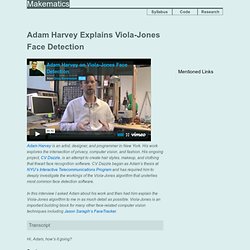
His work explores the intersection of privacy, computer vision, and fashion. His ongoing project, CV Dazzle, is an attempt to create hair styles, makeup, and clothing that thwart face recognition software. Face detection using HTML5, javascript, webrtc, websockets, Jetty and OpenCV. Through HTML5 and the corresponding standards, modern browsers get more standarized features with every release.
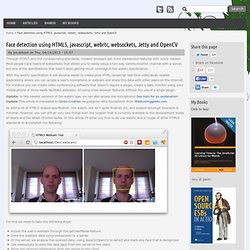
Most people have heard of websockets that allows you to easily setup a two way communication channel with a server, but one of the specifications that hasn't been getting much coverage is the webrtc specificiation. With the webrtc specification it will become easier to create pure HTML/Javascript real-time video/audio related applications where you can access a user's microphone or webcam and share this data with other peers on the internet. Camshift.pdf (application/pdf-object)
Face Tracking with CAMShift using OpenCV/SimpleCV. Import cv2 import cv2.cv as cv def camshift_tracking(img1, img2, bb): hsv = cv2.cvtColor(img1, cv.CV_BGR2HSV) mask = cv2.inRange(hsv, <span class="skimlinks-unlinked">np.array((0</span>., 60., 32.)), <span class="skimlinks-unlinked">np.array((180</span>., 255., 255.)))
Facerec_python.pdf (application/pdf-object) Blog:fisherfaces [ Some time ago I have written a post on Linear Discriminant Analysis, a statistical method often used for dimensionality reduction and classification.
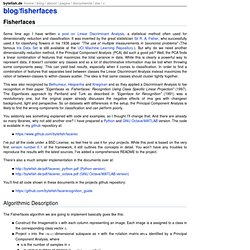
It was invented by the great statistician Sir R. A. Fisher, who successfully used it for classifying flowers in his 1936 paper "The use of multiple measurements in taxonomic problems" (The famous Iris Data Set is still available at the UCI Machine Learning Repository.). But why do we need another dimensionality reduction method, if the Principal Component Analysis (PCA) did such a good job? Well, the PCA finds a linear combination of features that maximizes the total variance in data. This was also recognized by Belhumeur, Hespanha and Kriegman and so they applied a Discriminant Analysis to fae recognition in their paper "Eigenfaces vs. You seldomly see something explained with code and examples, so I thought I'll change that. I've put all the code under a BSD License, so feel free to use it for your projects.
Algorithmic Description. Blog:gender_classification [ My last post was very long and I promise to keep this one short.
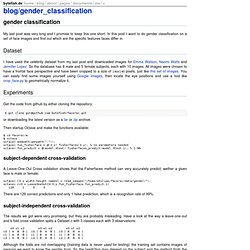
In this post I want to do gender classification on a set of face images and find out which are the specific features faces differ in. Dataset I have used the celebrity dataset from my last post and downloaded images for Emma Watson, Naomi Watts and Jennifer Lopez. So the database has 8 male and 5 female subjects, each with 10 images. Guo's Publications. Gender Classification with OpenCV — OpenCV v2.4.9 documentation. Introduction A lot of people interested in face recognition, also want to know how to perform image classification tasks like: Gender Classification (Gender Detection)Emotion Classification (Emotion Detection)Glasses Classification (Glasses Detection)...
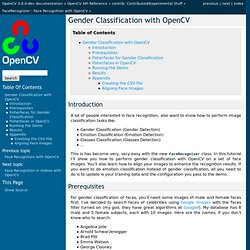
This is has become very, very easy with the new FaceRecognizer class. GAZE ESTIMATION. Opengazer: open-source gaze tracker for ordinary webcams. MORPH Database (non-commercial) Cookies Required You must have session cookies enabled in your web browser before you can add items to your shopping cart.

These cookies are not written to your computer's hard drive. They allow your selections to be saved while you shop, and are then deleted when you close your browser or log out of your registered user session. Web Browsers. PAMI10Guo.pdf (application/pdf-object) Facial Age Estimation. Facial Age Estimation Age estimation is the determination of a person’s age based on biometric features.
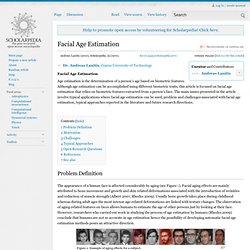
Although age estimation can be accomplished using different biometric traits, this article is focused on facial age estimation that relies on biometric features extracted from a person’s face. The main issues presented in the article involve typical applications where facial age estimation can be used, problem and challenges associated with facial age estimation, typical approaches reported in the literature and future research directions. Problem Definition The appearance of a human face is affected considerably by aging (see Figure 1). Perceptual Computing SDK. Computer Vision:Algorithms and Applications (draft) OpenCV. Opencvsharp - OpenCV wrapper for .NET Framework. Emgu CV: OpenCV in .NET (C#, VB, C++ and more) * Multiple face detection and recognition in real time.
Download FaceRecPro Optimized Version: Source code, Demo: All binaries references, algorithm enhanced - 6.5 MB Introduction The facial recognition has been a problem very worked around the world for many persons; this problem has emerged in multiple fields and sciences, especially in computer science, others fields that are very interested In this technology are: Mechatronic, Robotic, criminalistics, etc.
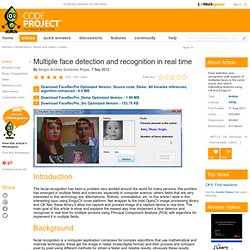
In this article I work in this interesting topic using EmguCV cross platform .Net wrapper to the Intel OpenCV image processing library and C# .Net, these library’s allow me capture and process image of a capture device in real time. The main goal of this article is show and explains the easiest way how implement a face detector and recognizer in real time for multiple persons using Principal Component Analysis (PCA) with eigenface for implement it in multiple fields. Background Traditional text taken from [1] Kinect + Emgu « Geek-Press. Sorry about the inactivity but having and a daytime job and girlfriend sometimes leaves us without time. Started to play with Computer Vision and Kinect, didn't done a big thing but I was completly unaware of how CV works and after reading a while about it I hear that Emgu is a great wrapper for openCV library.
In fact you can do some face detection without any worries at all. So let's do a hands-on on this library For this example you need. Level 3c - How To Improve Face Detection. QUESTION: "Face detection result is not up to my expectations/needs! How do I improve the detection results?! "Simple Solution: Is your problem something like: not all faces are being detected ? SERVOMagazine Series, Seeing with OpenCV. How Face Detection Works.
OpenCV's face detector uses a method that Paul Viola and Michael Jones published in 2001. Usually called simply the Viola-Jones method, or even just Viola-Jones, this approach to detecting objects in images combines four key concepts: Simple rectangular features, called Haar features An Integral Image for rapid feature detection The AdaBoost machine-learning method A cascaded classifier to combine many features efficiently The features that Viola and Jones used are based on Haar wavelets. Haar wavelets are single wavelength square waves (one high interval and one low interval). Face Recognition with OpenCV — OpenCV v2.4.2 documentation. Introduction OpenCV (Open Source Computer Vision) is a popular computer vision library started by Intel in 1999. The cross-platform library sets its focus on real-time image processing and includes patent-free implementations of the latest computer vision algorithms.
In 2008 Willow Garage took over support and OpenCV 2.3.1 now comes with a programming interface to C, C++, Python and Android. OpenCV is released under a BSD license so it is used in academic projects and commercial products alike. OpenCV 2.4 now comes with the very new FaceRecognizer class for face recognition, so you can start experimenting with face recognition right away.
Alexandre Alahi - FREAK. - What is the problem? A large number of vision applications rely on matching keypoints across images. The last decade featured an arms-race towards faster and more robust keypoints and association algorithms: SIFT, SURF, and more recently BRISK to name a few. These days, the deployment of vision algorithms on smart phones and embedded devices with low memory and computation complexity has even upped the ante: we need to make descriptors faster to compute, more compact while remaining robust to scale, rotation and noise. - What is our solution? We propose a novel keypoint descriptor inspired by the human visual system and more precisely the retina, coined Fast Retina Keypoint (FREAK). AForge.NET. AForge.NET is a computer vision and artificial intelligence library originally developed by Andrew Kirillov for the .NET Framework. The source code and binaries of the project are available under the terms of the Lesser GPL and the GPL (GNU General Public License).
Another (unaffiliated) Google Code project named Accord.NET extends the features of the original AForge.NET library. Point Cloud Library. The Point Cloud Library (or PCL) is a large scale, open project for point cloud processing, started by Willow Garage, with the purpose to accelerate 3D algorithmic work in perception for use in robotic applications. The PCL framework contains numerous state-of-the art algorithms including filtering, feature estimation, surface reconstruction, registration, model fitting and segmentation, to name a few. PCL is released under the terms of the BSD license and is open source software. * PCL - Point Cloud Library. Top 10 Robotic Kinect Hacks. Point Cloud Library (PCL) Users - Face / Head Tracker. GPGPU. OpenCL. CLBenchmark - High-performance compute benchmark for OpenCL 1.1 environment. CUDA. CUDA (Compute Unified Device Architecture) is a parallel computing platform and programming model created by NVIDIA and implemented by the graphics processing units (GPUs) that they produce.[1] CUDA gives program developers direct access to the virtual instruction set and memory of the parallel computational elements in CUDA GPUs.
Using CUDA, the GPUs can be used for general purpose processing (i.e., not exclusively graphics); this approach is known as GPGPU. Unlike CPUs, however, GPUs have a parallel throughput architecture that emphasizes executing many concurrent threads slowly, rather than executing a single thread very quickly. CUDA provides both a low level API and a higher level API. The initial CUDA SDK was made public on 15 February 2007, for Microsoft Windows and Linux. Example of CUDA processing flow 1. Background[edit] The GPU, as a specialized processor, addresses the demands of real-time high-resolution 3D graphics compute-intensive tasks. Advantages[edit] Limitations[edit] eMotion - Facial Expression Recognition. Finally A TV Ad That Encourages Hand Gestures: Brainient Taps Kinect For Interactive TV Ads. European online video startup, Brainient, whose BrainRolls system enables advertisers to incorporate interactive elements into online video adverts to boost brand engagement and recognition — such as clickable Facebook Like buttons and photo galleries — is tapping into Microsoft’s Xbox Kinect gesture-based controller to push into the connected TV space.
Brainient already sells its BrainRolls product for viewing video ads on computers, smartphones and tablets — its system automatically tailors the ad to the type of screen it’s being viewed on, and can therefore offer advertisers the ability to run what is effectively the same campaign across a variety of devices. Today it’s opening a new front with the launch of an interactive video ad that taps up Kinect gestures to extend interactive video ads to connected TVs. Accenture Innovation Awards Concept van de Week – ThirdSight: persoonlijke reclame. GranataPet Snack Check. * Facedeals - Check-In with Your Face.
News - SelfAdvert. Rhonda Software: Computer Vision. VANtureLabs - Advanced Computer-vision Applications. 121VIEW Digital Signage Media. Who We Are 121View is a digital media software development company. We provide two way digital signage media networks that interact with customers in the marketplace. We target high traffic areas, customer point of purchase decision and information transfer locations such as shopping malls, mass transit systems, hospitals, retail, education, government and entertainment venues. view details. Predict Gaze. The Face Recognition Company: FaceVACS-SDK. Automated Audience Measurement & Retail Intelligence Solutions. Quividi - Automated Audience Measurement of Billboards and Out Of Home Digital Media - OOH - Home. Immersive Labs - Smart Face Detection Software - Immersive Labs.
Retail Intelligence. Video-based Heart Rate Measurement From Human Faces. UIST 2012 - 25th Symposium on User Interface Software and Technology (October 7-10, 2012 Cambridge, Massachusetts) Freehand 3D Interactions Anywhere Using a Wrist-Worn Gloveless Sensor. Gender, Age, and facial expression Classification. CV Dazzle: Camouflage From Computer Vision by Adam Harvey. One-shot learning. Vision Lab; Prof. Fei-Fei Li. One-Shot Learning of Object Categories. ChaLearn Gesture Challenge: Design and First Results. * Wearable sensor system automatic maps building while wearer is moving. Converting 2-D Video to 3-D. TYZX - Systems that See - Embedded Vision Systems. Www.trumedia.co.il. VideoMining - VideoMining Solutions. GazeHawk - Webcam Eye Tracking - Ad Testing and Optimization. COMPUTER VISION wiki.